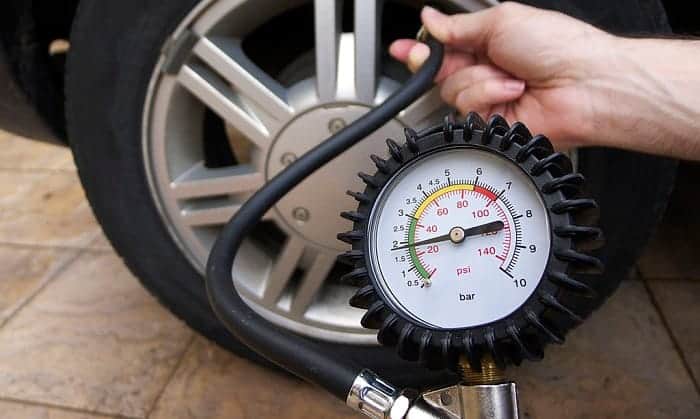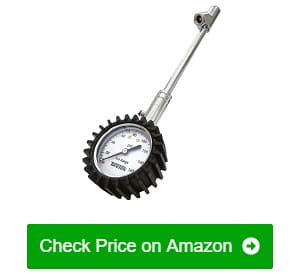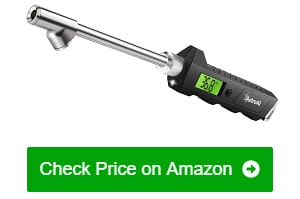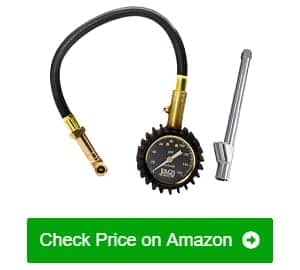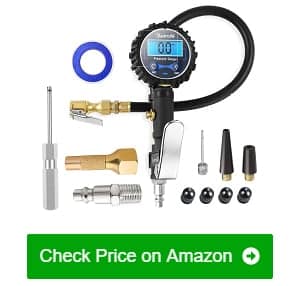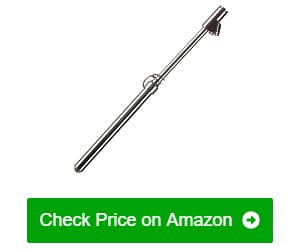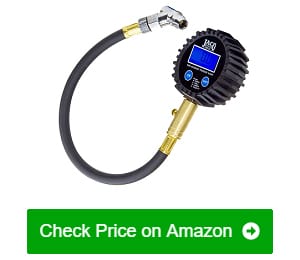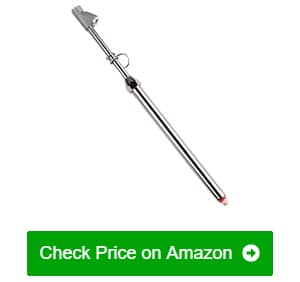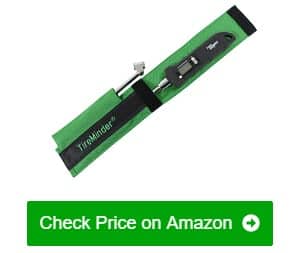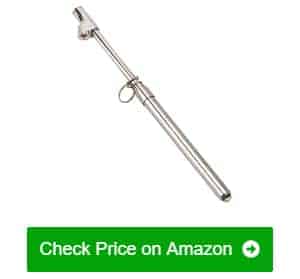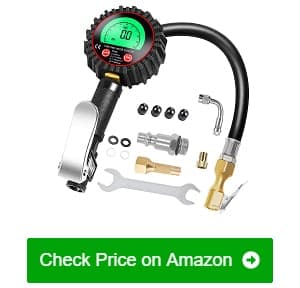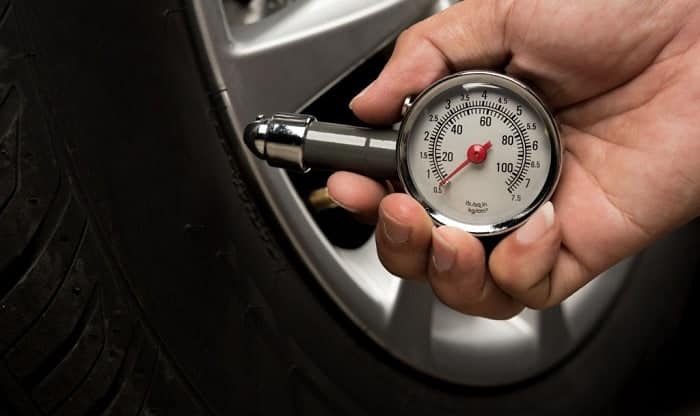You may think that you do not need the best RV tire pressure gauge, but you have to avoid scrimping on this one to help keep your RV trips safe. A tire gauge is necessary for ensuring that you properly inflated your RV tires before you go on a long road trip.
Having a tire gauge will allow you to monitor the air pressure of your RV’s tires. You will know if you need to release a bit of air from the tires or bring your RV to the nearest gas station to have your tires pumped with more air. This little tool is a lot more important than you think, so you should at least try to find the best one you can afford.
Here are some great choices of tire pressure gauge you have to check out:
Table of Contents
Best RV Tire Pressure Gauge Reviews
1. TireTek Tire Pressure Gauge
I think that this product from TireTek is the best tire pressure gauge for an RV. The product is an incredible choice for your large RV with dual tires because the inner tires usually have their valves pointing inwards.
This gauge has an extended stainless-steel shaft, which helps increase its lifespan and takes pressure readings even in awkwardly positioned tire valves. Hence, you can utilize it in the long haul.
The TireTek gauge also has a needle holding feature that allows you to read the tire pressure even if you pull it off the valve. The older models of dial tire gauges require checking the tire pressure with the gauge still attached to the tire valve. This unit only requires pushing it into the valve for a second or two to let the needle register the tire pressure.
Another nice thing about it is that it is purely analog, making it unnecessary to use any batteries for proper operation. You can start using this product straight out of the box and enjoy it for many years to come. Just remember to take care of the gauge so it can take care of you as well.
- Measures air pressure even when the valve is in an awkward position
- Durable and long-lasting with a stainless-steel shaft
- Needle-hold feature for convenience
- Purely analog, making batteries unnecessary
- Works well for large RVs with dual tires
- Quite tricky to read in low-light conditions
2. AstroAI Digital Tire Pressure Gauge
I am also impressed with this tire pressure gauge from AstroAI. It is a budget-friendly product with multiple functions for breezy usage.
I specifically like its bright green backlit display. Aside from giving an accurate reading up to a tenth decimal place, it is also easy to read in low-light conditions with the display’s help. This feature also shows accurate readings, making it easier to monitor the health of your tires.
I appreciate its dual-head design, which promotes ease in measuring tire pressure. The feature makes it ideal for Class A RVs with large dually tires.
This gauge also has a non-slip outer texture, making it easy to grip. Add to that the built-in grooves on the handle, and you will indeed have no problems holding it. You do not need to worry about your hands slipping off the handle and hitting your knuckle on the rim.
- Comes with a bright backlight for easy read and use in low-light conditions
- Provides highly accurate readings for effective monitoring of tires’ condition
- Dual-head design for pull and push valves
- Easy to grip since it has a non-slip outer texture
- The LED guide light does not focus enough
3. JACO EliteProPlus Tire Pressure Gauge
Jaco is one of the most popular brands providing high-quality measuring equipment, and its tire gauge is worthy of carrying the brand name. In fact, the product comes with a lifetime guarantee for you to utilize its excellent features with peace of mind.
This product is calibrated to be accurate within +/- 1.5% of the actual tire pressure, which gives you total control over your tires.
It feels comfortably hefty and solid in your hands mainly because it used 100% brass for construction. You don’t have to worry about it dropping and breaking it due to the shock-resistant rubber shell. The unit is both so durable and flexible that it will take more than that to put this out of order.
I also find the built-in air bleeder useful and convenient. Other gauges may require you to make the air bleed out of the valve, check the tire pressure then repeat until you get the right one. It’s not the case with this unit. Just press the air release button and stop once the tires hit the right air pressure.
Also, I am happy that even though this gauge is not backlit, it still has a glow-in-the-dark face. Although it is not quite as useful as a backlit screen, the illumination provided is more than enough to get a good look at the dial face.
- Calibrated to within +/- 1.5% accuracy
- Highly durable, thanks to its 100% pure brass construction
- Comes with shock-resistant shell to withstand dropping
- Equipped with a convenient air bleeder
- Features a glow-in-the-dark dial
- Has a 100% lifetime warranty
- Takes some first turns to have accurate readings
4. AstroAI Digital Tire Inflator with Pressure Gauge
This product is one of the most accurate digital pressure gauges that I have ever tried. Right out of the box, it already gave me quite accurate readings. Remarkably, this unit can provide readings within one percent of the actual air pressure.
The AstroAI pressure gauge displays readings in four different pressure units. It does not matter if you are from a country that uses Imperial or Metric units. You can still count on it to give you the information you need. This gauge offers readings in psi, kPa, bar, and kg/cm^2.
I am also happy to connect this gauge to an air compressor, promoting ease in filling up the while still continuously monitoring the air pressure. It features a quick-connect valve, so there is no tightening of screws involved. This kit also comes with adapters for inflating other things other than your tires.
Moreover, it has a straight-locking chuck for added convenience and safety. You do not need to press the chuck onto the valve. Just clip it onto the valve, and it will stay there securely. The lock will hold onto the valve stem securely, so you can pump air into your tire without worrying about the gauge flying off the valve.
Its construction boats of excellent durability. Since the piece is a combination of heavy-duty stainless steel and brass, it can offer us long-term use despite the abuse.
- Highly accurate and gives a reading that is within +/- 1%
- Gives you a choice of 4 pressure units
- Has a straight-locking chuck for convenience and safety
- Comes with a quick-connect input valve
- A solid build constructed out of heavy-duty stainless steel and brass
- Restricts the air from the compressor quite a bit
5. CZC AUTO Tire Pressure Gauge
If you have a large RV, like a Class-A or similar, then you also probably have dual tires at the back, and those have awkwardly-positioned valve stems. In that case, you need a tire gauge, like this one from CZA Auto. You just have to position the chuck over the gauge and pull back.
Even though this analog tire gauge has a dozens-of-years-old design, it is still quite popular. One reason is its heavy-duty construction that can handle air pressure up to 150 psi. It does not have any small and moving parts, making it last for many years with hardly any maintenance.
I think the popularity of this unit is also because it is easy to use. It is simple, without any buttons to push. You don’t have to calibrate anything, too. Just push chuck onto the valve, and the scale will pop out the other end for you to read.
Many also refer to it as a pencil gauge because it is roughly the same size and shape as a pencil. With that, you do not need to make room for it in your already full toolbox. You can just throw it into your glove box, and it will hardly take up any space at all.
- Dual foot design for large vehicles
- Heavy-duty structure, allowing it to handle tire pressures up to 150 psi
- Easy to operate with one press on the chuck
- Compact, making it save storage space
- Not as accurate as digital tire gauges
6. JACO ElitePro Digital Tire Pressure Gauge
Jaco calibrated this ElitePro Digital Tire Pressure Gauge to get as close as possible to the actual air pressure in the tires. It can even give readings that are within +/- 1.5% of the correct tire pressure. For your information, the product is certified by ANSI 2A standards for professional use.
You do not need to worry about dropping and breaking this precision tool as it has a solid brass and stainless-steel construction. A robust rubberized plastic material also wraps its exterior, so it would take several solid hits before it can register any damage.
It also has a clearly labeled dial face, ensuring ease when reading, even if you do not have the best vision.
A nice touch added to this tire gauge is the bleeder valve. There will always be times when you overinflate your tires, which can be as dangerous as underinflated. Having a bleeder valve means that you can let out enough air from the tires with the gauge still attached.
- Calibrated to a precision of up to 1.5%
- Certified with ANSI-2A standard for professional use
- Rugged design with its solid brass and stainless steel materials
- Features an easy-to-read dial face
- Equipped with a bleeder valve
- The swiveling chuck makes it tricky to maintain contact with the tire valve
7. WYNNsky Extension Tire Pressure Gauge
The great thing about stainless steel and brass pencil tire gauges is that they can last for a long time without tiresome maintenance. It is the type of tool that you can throw into the toolbox or the glove box and just forget about it until the next time you need it.
If you own a large vehicle, like an RV, then you will need a dual head chuck to get an accurate reading on the inner tires. This heavy-duty device comes with a push/pull valve so that you can use it on awkwardly-positioned tire valves.
Unlike the smaller pencil-type gauges rated for around 60 psi max, this device has limits that go up to 160 psi, perfect for RV tires.
You do not even need to read the manual to know how to use this gauge. Just align the chuck with the tire valve, and then push it in until the scale pops out of the other end.
This convenient and compact design also features a small loop for us to hang it up when not in use. It also has two pressure measurement units: PSI and kPa, depending on which one is your preference.
- Built to last – can serve its purpose for many years
- Features a dual-head chuck, ideal for large tires with awkwardly-placed valves
- Measures air pressure up to 160 psi
- Easy to use: align the chuck and push it in
- Features a small loop for hanging when not in use
- Comes with two pressure measurement units: PSI and kPa
- Not as accurate as other dial and digital gauges
8. TireMinder Digital Truck and RV Gauge
What I like the most about this TireMinder gauge, which I have not seen in other digital gauges yet, is its interchangeable shafts. That means you can choose between a straight chuck and an angled chuck, depending on which one feels more comfortable.
You can also see the handle of this tire gauge coated with a rubber-like coating that repels water and sweat, making it easy to grip. I suffered from innumerable split open knuckles because my hands slipped off the handles of my tools, but that hasn’t happened with this gauge.
Another neat feature is that there is a front-facing flashlight. It is helpful since I can easily use it even in the dark, but I also use it to make it easier to find things inside my glove box. The LED light is not that strong, but its brightness suffices, allowing you to see the tire valve and even the valve cap if you drop it.
I can also say that it is one of the most accurate tire gauges that I have enjoyed using. It is calibrated to read within +/- 1 psi, making it almost as accurate as laboratory-grade gauges, although not as sensitive.
- Comes with interchangeable shafts
- Features a rubber-like water-resistant coating for a non-slip grip
- Features a front-facing flashlight for use in low-light conditions
- Accurate reading up to +/- 1 psi
- The switch is a bit soft
9. MEASUREMAN Truck Tire Gauge
I was impressed by the MEASUREMAN truck tire gauge’s durable feel in my hand. This gauge takes pride in its solid brass structure, and it has quite a bit of heft to it.
Unlike other pencil gauges, the scale has clear markings. The white background also made it easy to read, even if the lighting condition is not ideal. You also know that it is made for heavy-duty use because the markings go up to 150 psi, making it perfect for RVs.
Compared to the other pencil gauges that I have used, the MEASUREMAN is one of the most accurate. This gauge is calibrated to give readings as accurate to +/- 1 psi from the actual air pressure inside the tires. It is already impressive for an analog device that is commercially available.
This gauge also came with a dual-head chuck. The straight head is for the regular valves positioned pointing outward. The reversed and angled head is for the valve of dual tires. You reach into the tires, and you pull on the gauge to contact the valve.
- Heavy and feels durable brass construction
- Easy-to-read scale with markings up to 150 psi
- Features a dual-head chuck for reaching awkwardly-placed valves
- Quite accurate for a pencil gauge
- The chuck is a bit too large, a bit tricky to make a good seal
10. TiGaAT Digital Tire Pressure Gauge Inflator
If you look for a Digital Tire Pressure Gauge Inflator offering readings within 1% of the actual tire pressure, look no further than this device from TiGaAT.
The display of this digital tire gauge is big and bright, making it easy to read. The backlight is also bright enough that you can use the gauge, even on the darkest nights. Moreover, you have a separate switch for the backlight. It helps a lot in preserving battery power.
Another nice touch is the built-in air bleeder. There have been plenty of times when I have accidentally overinflated my tires – either the pump I used does not have a gauge, or I flat out forget how much air each tire needs. The air bleeder is useful in this case as I can easily remove excess air from the tires.
I am also happy that I can connect it directly to an air compressor. It means I can inflate my tires while monitoring the tire pressure and bleed excess air if needed. It is one of the best and most accurate ways to inflate your tires.
This product comes with a rubber protective pad to handle dropping or vibration. Furthermore, this gauge can perform flawlessly for a prolonged time due to its solid structure that resists rust and corrosion, as well as leaking issues.
- Highly-accurate, allowing it to come as close as +/- 1% of actual tire pressure
- Easy to use and read, thanks to the backlit display
- Features an air bleeder
- Easy to connect to an air compressor to inflate the tire
- Comes with a rubber protective pad to handle dropping and vibration
- A solid structure resisting rust, corrosion, and leaking issues
- The male quick-connect fitting is not the standard size
Best RV Tire Pressure Gauges Buying Guide
One mistake that many people make when buying tire pressure gauges is that they think they all work the same, so there is no point finding the best one. But, hitting the road with either underinflated or overinflated tires may lead to fatal accidents.
There are many other reasons why you should get a proper RV tire pressure monitoring system. One is that it will help your tires last longer. Undeniably, RV tires are quite expensive, and they may get ruined fast by running them with improper air pressure.
Overinflated and underinflated tires can ruin the inner steel belt. It is the part that holds the rubber tire walls together. If the steel belt gets broken, you will see ugly bulges at the sides of your tires, and it is a warning sign that your tires might explode.
Type of gauge – Note that many tire gauges are available for you to choose from. If you are in the market for one, then the pencil type is a good choice. This gauge got its name from its pencil-like shape. It is the most popular type of tire gauge mainly because it has been in the market the longest.
Another selling point of this type is that it is also the most durable. There are no moving parts nor small parts that might get dislodged. It does not also have screens to crack. If you maintain it properly, you will use this gauge for as much as a decade.
The dial type is another choice. Instead of a gradated stem that pops out one end, a dial gauge has an actual dial to help you read the tire pressure. It has a dial with a magnified scale, providing a more accurate pressure reading than pencil gauges where the gradations are a bit too close together, so there is still a bit of guesswork involved.
The last type is the digital gauge. With this gauge, you no longer need to count the gradations on a dial, as you can already see the amount displayed on the LED screen.
Another thing that makes the digital type great is that it immediately displays the tire pressure in increments of a tenth of a psi. Bus owners who need to monitor the pressure in an entire fleet of vehicles constantly also use this type.
With the multiple choices you have, it is advisable to get one depending on your specific preferences. If you want durability and longevity, go for the pencil type gauge.
Maximum pressure reading – You need to find a tire gauge that has a maximum pressure reading that is much higher than the maximum pressure that the gauge can measure. For instance, you may not get an accurate reading if you use a tire gauge meant for use on bicycles when you use it on the massive tires of your RV.
If you think of getting a stick/pencil tire gauge, make sure that it is long enough to read high tire pressures without bottoming out the gauge effectively.
Ease of use – It is best to buy a tire pressure gauge that you can operate using just one hand. Most stick gauges have one-handed operation already, as well as most digital tire gauges. On the other hand, you can find some dial gauges that require two hands to operate properly.
Another consideration for ease-of-use is when you need to reset the gauge, like when you need to take another reading. With stick gauges, you just need to push back the stick measure back into the body.
On the other hand, the digital and dial tire gauges require you to push a button to bring the gauge back to zero. Just make sure that you buy gauges where the buttons have clear labels.
Another neat feature that greatly improves usability is the dual-head chuck. Ideally, the gauge should have a push and pull chuck. It means you can use one of the heads to measure your tire pressure normally. You can also use another chuck when the valve is positioned pointing inside the rim, like in large truck tires and dually tires.
Easy to read – If you have a bit of a problem with reading tiny prints, then you might have a bit of trouble reading sticks, and dial gauges as the lines can be quite tiny. You may have more luck with digital tire pressure gauges as they have bigger LCDs. Some even have backlit screens so you can read them in the dark.
It is not possible for stick gauges as these are purely mechanical gauges. Most dial gauges are also tricky to read in low-light conditions. However, some brands offer dials with glow-in-the-dark faces that will make reading them a bit easier.
If such a feature is vital for you, the digital pressure gauges are your best bet. These items do not only have larger displays but also feature backlit for easier reading.
Grip/weight/size – If you will be using the tire gauge on a large vehicle with many wheels, like an RV, you will need to use something convenient to hold. It should also be able to give you just the right amount of grip. If you can, get a gauge with a textured handle, thereby preventing it from slipping from your hands.
The weight should make the gauge feel solid in your hands. It should be solid and sturdy enough that even if you accidentally drop it, you just know that it will not get damaged a lot, if at all. However, it should not be so heavy or out of balance. The center of gravity should be around the base of the handle to make it easier to hold and wield.
As for the size, you need to get one that can fit in your glove box. A good tire gauge should be small enough that you will not have any trouble bringing it with you wherever you go. If possible, get a pocket-size gauge.
Pressure units – Even though psi (pounds per square inch) is the most widely accepted unit of pressure in North America, that is not the only one used. The Metric system has several, like pascal, atm, bar, and so on. However, regarding the tire pressure, other countries use bar and kilopascal (kPa) aside from psi.
Most stick tire pressure gauges only come with psi measurements, while dial gauges can have two (psi and kPa). If you want variety, there are certain brands of digital tire gauges that use several different pressure units. It is a purely subjective quality, but it is a pretty handy feature to have.
Durability – When it comes to the number of uses you can get out of them, the dial and digital tire pressure gauges are more durable than pencil pressure gauges. After maybe months of continuous use, the piston inside the sealed pencil gauge tube will deteriorate. Also, even if a bit of air gets past the piston, you will get an inaccurate reading.
However, when it comes down to resistance against drops and hitting against surfaces, the pencil-type tire gauge should win. These gauges do not have any sensitive parts that will get knocked out of position when dropped. It does not also have glass screens that would crack.
The most durable out of all the types of gauges is the pencil type. It does not have any moving parts and no sensitive electronics that will get seriously damaged when accidentally dropped. This type also requires little to no maintenance whatsoever, but you may compromise a bit since it is less accurate than the others.
Accuracy – The reason why you need a gauge in the first place is that it is necessary to have a reliable and accurate means of measuring the air pressure in your tires. Pencil tire gauges are always proven to be an accurate means of measuring air pressure, granted you know how to use and read them properly.
Digital gauges, on the other hand, will allow you to easily measure tire pressure accurately to a tenth decimal place. It may seem like an overly extensive list just for a simple tire gauge, but such things are important points to consider if you want to get the best tire pressure gauge or something that may not even give you the right reading most of the time.
It is also an important feature if you are serious about monitoring the air pressure in your tires. Having an extremely accurate tire gauge will let you know if there is even a small puncture in your tires.
Additional features – Some tire gauges have other tools incorporated into them. These items are like all-in-one tools. Perhaps one of the most common multi-tools of this type is the tire gauge that comes with a couple of survival tools built-in, like a car window breaker and a seatbelt cutter.
On the flip side, some multi-tool brands feature a tire pressure gauge. It is a great idea to save space as you can have multiple tools, but it would only take up the same amount of space that one tool would.
You can also find tire gauges that can latch onto the valve stem while also having another input valve that you can connect to an air compressor. It allows you to monitor the tire pressure constantly while you are inflating your tires. It is a good tool to have if you have your own heavy-duty air compressor at home to maintain the tire pressure yourself.
Price – It should not be too much of an issue since most of the tire pressure gauges that are on the market nowadays are quite cheap, especially the pencil-types. You do not need to spend much to get an accurate tire pressure gauge.
Also, note that unless you work at the quality control department of a tire company, you have no use of a tire gauge to measure in increments of thousandths.
Who Makes the Best RV Tire Pressure Gauge?
Many different manufacturers offer their own brand of tire pressure gauges. Still, having tested dozens upon dozens of them, I discovered that the best ones include TireTek, AstroAI, JACO, CZC Auto, WYNNsky, TireMinder, Measureman, and TiGaAT.
Other than that, Eeztire tire pressure monitoring system or Bellacorp tire pressure monitoring system can be ideal choices.
If you can, it would be best to try to search for tire gauges from the mentioned brands. I can guarantee that you will be quite satisfied with your purchase.
What Is the Most Accurate Tire Pressure Gauge For RV?
If you want the most accurate tire pressure gauge, you should get the digital ones if you can. These gauges can measure the air pressure in your tires with accuracy up to a tenth of a psi. Other types are also quite accurate depending on the brand, but digital gauges are the most accurate and easiest to read by far.
You can get a highly calibrated analog tire gauge, but you will discover that these products are quite expensive. Most of them are also very sensitive that they are a bit too high maintenance for something you will be using to check if your RV tires have enough air in them.
If you are only interested in getting accurate tire pressure readings, you can just get a mid to high-end digital tire gauge to give you the same accurate readings.
What Pressure Should My RV Tires Be?
It will depend on the manufacturer of your vehicle. You can find the recommended tire air pressures for both the front and rear tires written on a small metal plate somewhere in your car. You can usually find this information on the door jamb on the driver’s side of the car.
If it is not there, try looking at the passenger’s side. If you cannot seem to find the tire information plate, you can definitely find the information you need in the user’s manual of your vehicle.
You need to note that the recommended tire pressure mentioned on the body of your vehicle is the cold tire pressure. It means you can read the tire pressure when the RV has been parked overnight or if you just drove it a couple of minutes to the nearest gas station.
The reason is that as the wheels of the RV get hot, the air inside would expand. It can then increase the air pressure inside accordingly.
Are Pencil Tire Gauges Accurate?
It will depend on the brand of the pencil (aka plunger) type tire pressure gauge you have. Some of the more expensive brands of pencil gauges are calibrated for maximum accuracy, but most of the cheaper ones are not that accurate.
A general rule, when it comes to pencil gauges, is they are +3 or -3 psi when new but you can expect them to become a bit more accurate with time. Other factors that might affect the accuracy of the gauge include humidity, temperature, and altitude.
The gauge’s age will also contribute to the deterioration of its accuracy. The older the gauge gets, the piston inside the body will start to deteriorate and lets more air escape through the sides, making them less accurate.
Should you spend more money on a highly calibrated pencil gauge? Not really. You should just get an already accurate digital tire gauge for a fraction of the cost of the calibrated pencil gauge but works just as well if not better.
Care and Maintenance
The nice thing about tire gauges is that all of them are pretty low-maintenance. In truth, aside from the common sense that you should avoid dropping your tire gauge on hard surfaces, the only thing that you should do to keep your tire gauge in top shape is to store them properly.
If your gauge came with a storage case, always put them back there after every use. Do not just throw your tire gauge into the toolbox with the other tools. It is a great way to beat your gauge into an unusable mess. Place the gauge in the carrying case it came with and put it in your glove compartment to keep it safe.
Check out for the RV fender skirts guide if you need. Also, a guide for RV air compressor here to find the right choice.
Conclusion
Even though it is such a simple and small tool, having the best RV tire pressure gauge is one of the most important decisions you will make as an RV owner. Having this nifty little tool at your disposal will save not only your money on tires but also your life one day.
Note that many different brands of tire pressure gauges are available at present, so you should choose carefully the one that fits your needs perfectly. Once you find the right gauge for you, do not forget to regularly check your RV tires. With that, you will know if you need to inflate them or require thorough checking for holes.

Hi, I am Tom Hank, an RV-er since 2014. Back then, I started without much help. As you can imagine, the struggles are endless. But now, you do not have to begin your adventures knowing next to nothing about RV lives.


